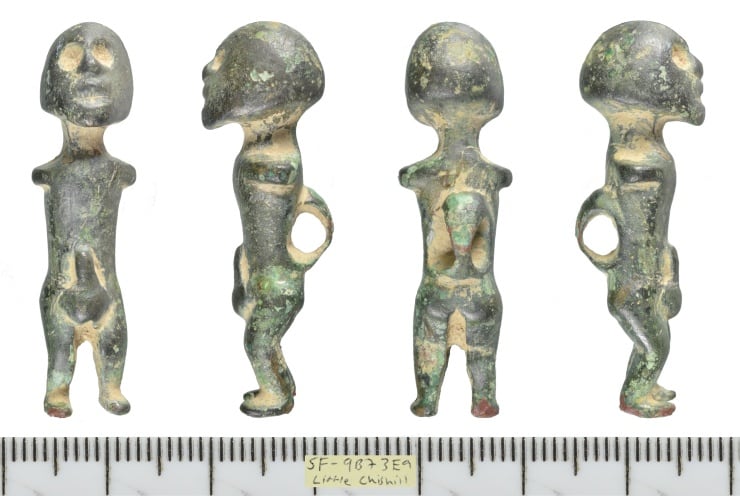Pěkný a při tom trochu smutný příběh.
He found a 2,000-year-old Celtic figurine, sold it at auction
Categories: Nálezy nejenom s detektorem ve Velké Británii a Irsku
At Little Chishill in Cambridgeshire, detectorist Bob Jemmett managed to discover a unique Celtic bronze fertility figurine from the 1st century 6 years ago. He found it in a freshly ploughed field during a mass detector expedition. He reported the discovery to the Portable Antiquities Scheme and after subsequent investigation it was returned to him, stating that it did not qualify as a treasure. He offered it at auction this Friday.
"On 12 September 2018, I was metal detecting in a ploughed field at Little Chishill near Royston in South Cambridgeshire at an organised event. The weather was horrendous and it was raining but I persevered and there was a wonderful signal from my Minelab CTX 3030 detector," said Bob, now 75. "I dug down about ten centimetres and uncovered a small bronze naked male figure, which was subsequently used by the organisers as a logo in their publicity. As a result, detectorists from all over Europe asked me at the event if they could see 'Nobby', who is always in my pocket as a constant companion," he added.
The copper alloy figurine is 38mm tall and 12.53mm wide. It depicts a male figure with a distinctive phallus, elongated torso and short legs. The figure's head is disproportionately large, elongated with a protruding chin. It resembles a skull with dimples instead of eyes and a wide groove in the form of a mouth with lines representing teeth. The back of the figure has a circular loop that was used for hanging or fastening. The loop is quite badly worn, and experts have not yet agreed on how it was used.
Fertility figurines were of considerable importance in antiquity - they often served as amulets and were also used in rituals related to fertility, protection and health. The Little Chishill figurine is evidence of sophisticated craftsmanship and spiritual life. The only known similar one was found in Sussex in 2014, but this is slightly different. It has no facial curves, the arms are waist-length and it displays a small and flaccid phallus. Interestingly, it shares several features with the giant "Cerne Abbas", a chalk figure on a hillside in Dorset.
Another similar statue from the first century was produced by detectorist Paul Shepheard of Haconby in Lincolnshire two years ago. His unique bronze fertility figure, which continues to attract the interest of collectors and experts, is characterised by its large moving phallus on an articulated mechanism. It was sold at auction in 2022 for £2,200 (about 65,000 crowns), with an original estimate of between £800 and £1,200.
The Chishill figurine quickly went viral. News of her discovery spread in all directions. The finder named it Nobby and carried it in his pocket at all times. However, soon after, when someone broke into his house, Bob decided to sell the figurine. Years ago, it was still being assessed by the coroner under the original version of the 1997 Treasure Act. Because it wasn't made of precious metal and wasn't a set of coins, it wasn't declared a treasure. As of this year, it would already meet that status and would be offered to a museum for purchase.
Prior to the auction, it was expected to be auctioned for between £1,000 and £1,500 (approx. "It was really exciting to watch the sale, but I'm quite sad to see 'Nobby' go. I hope it will bring as much fun to the new owner as it did to me and my friends," said the now former owner, adding that the acquisition ofThe money will be used for a security system to secure his other finds from unwelcome thieves.
Roman Nemec
Sources: livescience.com, thehistoryblog.com, bbc.com, www.noonans.co.uk

 Haconba figurine with a movable penis
Haconba figurine with a movable penis
The article is included in categories:



